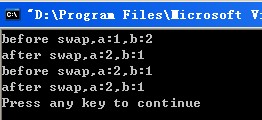//重載操作符+
Vector3 operator+(const Vector3 &a){
return Vector3(x + a.x,y + a.y,z+a.z);
}
//比較兩個數,如果相同返回0,如果v1大,返回1,如果v2大,返回-1
int compare(const int &v1, const int &v2)
{
if(v1 < v2) return -1;
if(v2 < v1) return 1;
return 0;
}
因為之前是用C#和Java比較多,就是無法理解這兩個函數的參數定義,為什麼要加上const和&。其實有時候看到&,*,T等符號就會頭大。如果在java中第二個函數我肯定就會這樣寫:
//比較兩個數,如果相同返回0,如果v1大,返回1,如果v2大,返回-1
int compare( int v1, int v2) www.2cto.com
{
if(v1 < v2) return -1;
if(v2 < v1) return 1;
return 0;
}
先不管上面的東西,再來看一個出現無數次的交換例子:
[cpp] view plaincopy
//把形參定義為引用類型
void swapOne(int& a, int& b)
{
int tmp = b;
b = a;
a = tmp;
}
//使用復制實參,只是改變局部副本,而傳遞函數的實參沒有修改
void swapTwo(int a,int b)
{
int tmp = b;
b = a;
a = tmp;
}
int main(int argc, char* argv[])
{
int a = 1, b = 2;
printf("before swap,a:%d,b:%d\n",a,b);
swapOne(a,b);
printf("after swap,a:%d,b:%d\n",a,b);
printf("before swap,a:%d,b:%d\n",a,b);
swapTwo(a,b);
printf("after swap,a:%d,b:%d\n",a,b);
return 0;
}
結果如下:

從結果看出,swapOne函數使用引用形參成功交換了a,b變量。而swapTwo函數沒有交換成功。
swapTwo使用的是普通的非引用類型的參數,是通過復制對應的實參實現初始化,傳遞函數的實參沒有改變。
而swapOne中,引用形參直接關聯到其綁定的對象,而並非這些對象的副本。所以交換會成功。
[cpp] view plaincopy
//比較兩個數,如果相同返回0,如果v1大,返回1,如果v2大,返回-1
int compare(const int &v1, const int &v2)
{
if(v1 < v2) return -1;
if(v2 < v1) return 1;
return 0;
}
上面這例子中的const還有什麼作用呢?原來使用const可以避免引用復制,提高性能,swapOne中當然不能使用了,因為它要改變值,而compare函數只是比較兩個數的大小,沒有交換,所以加上const可以提高性能。因為復制對象需要付出時間和存儲空間代價。
後記:最近無意中看到了《Effective C++》的條款20“寧以pass-by-reference-to-const 替換 pass-by-value”。中也談到了這個問題。
[cpp] view plaincopy
class Person{
public:
Person();
virtual ~Person();
...
private:
std::string name;
std::string address;
};
class Student:public Person{
public:
Student();
~Student();
...
private:
std::string schoolName;
std::string schoolAddress;
}
假設現在有這樣一個函數
bool validateStudent(Student s);
如果用by Value方式來調用就是
Student plato;
bool platoIsOk = validateStudent(plato);
因為Student類是繼承Person類,每個類都有兩個string。書上說,by value方式傳遞一個Student對象,總體成本是"六次構造函數和六次析構函數"!
如果改成成pass by reference-to-const:
bool validateStudent(const Student& s);沒有任何構造函數或析構函數被調用,因為沒有任何新對象被創建。